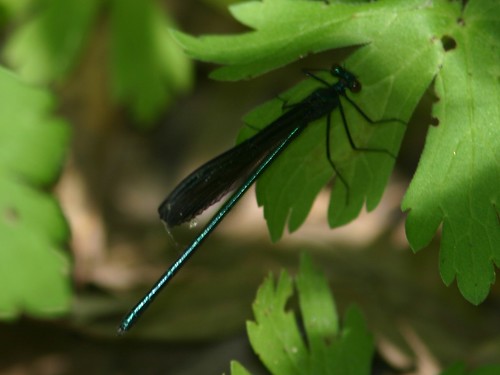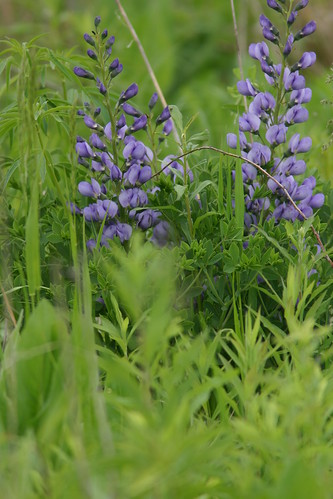Our granddaughter attended a nature discovery program at Spring Bluff Nursery, Sugar Grove, IL. We accompanied her there today. Of course, the flowers were beautiful.
These Blanket Flowers reminded us of New Mexico, where they sometimes covered the fields:
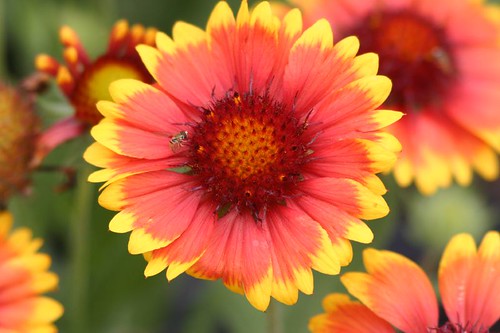
There were some delightful varieties– blues:
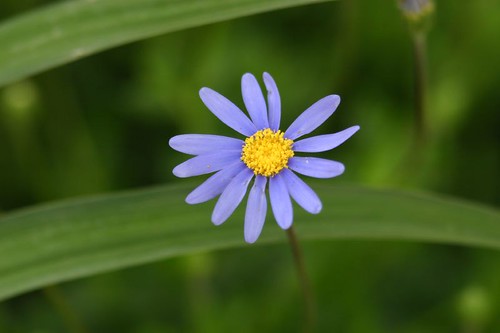
…miniature pansies:

A House Wren was singing nearby:

During winter, the nursery workers collect any cocoons they find on the trees, to be used in the nursery’s educational programs.
The children were shown a Hyalophora cecropia (Cecropia Moth) that had just emerged from its cocoon. The Cecropia is also known as the Robin Moth because of its red body and large size.
With a wingspan of 5 to 6 inches, the Cecropia is said to be the largest North American moth:
The male Cecropia had emerged the evening before. Within hours, a female was attracted to the entrance of its cage by powerful phermones, and they began mating.
The male is barely visible behind the larger female moth:
This little sequence that follows reminds me of my medical education. Referring to surgical procedures, we described the learning curve thus: “Watch one, do one, and then teach one.”
The teacher points to a creature in the little pond as Nieta studies it:
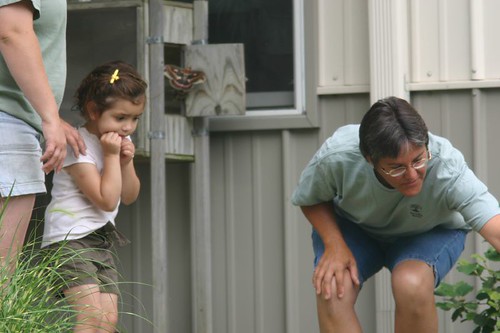
A frog! Her eyes reflect the joy of discovery:

The small frog sits on a lily pad, half submerged:

Now our Nieta puts her interpretive skills to work, exhibiting the frog to the other children:
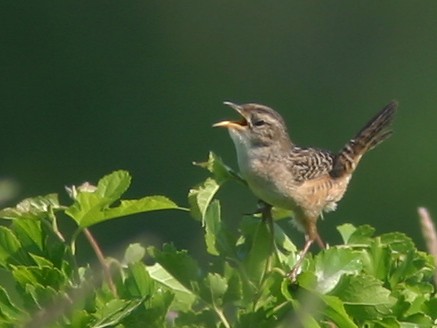
Here in Chicagoland, the birds have settled into the nesting season. At Nelson Lake in Batavia, a Sedge Wren (above), presumably the same one that I photographed a couple of weeks back, has shifted its singing perch from the south to the north side of the grass trail that leads to the east viewing platform. For some reason, a large area has been mowed and a couple dozen trees have been planted right in part of the regenerating prairie! The purpose of adding to the (already expansive) tree cover at the expense of long grass escapes me. At any rate, the bird now has a territory that hopefully will not be disturbed again during nesting season. This time I remembered to turn on the image stabilizer on my 300 mm lens, and got a much sharper image.
A White Pelican, probably the same one that was on the lake last summer, was still there, long after the flocks departed for their breeding grounds:

We have been spending lots of time with the granddaughters, so there have been many trips to the playground at the new Hawk’s Bluff Park in Batavia, only a short walk from their home. They were disappointed to find that a robin’s nest they had been watching was blown down by a strong wind storm. While walking Agramonte (their 6 month old Tibetan Mastiff) we had a small spotted fawn leap up out of the grass only 20 feet from the path, and later I saw a doe nearby.
We are watching this House Wren at her nest, just above the childrens’ slides and monkey bars:
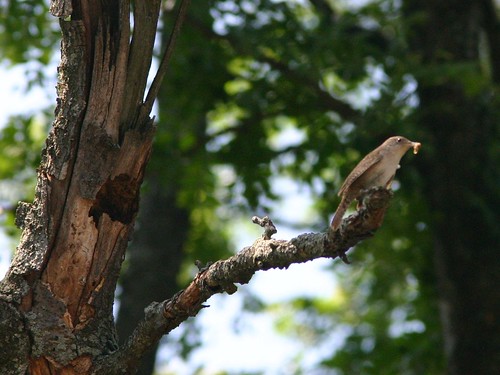
The search for photographic subjects led me to the banks of Mill Creek, where dragonflies and damselflies abound. Many of them must go unidentified, or merely put in a group with a request that readers with greater skills may wish to classify properly.
This damsel appears to be an male Ebony Jewelwing:
This Pond Damsel is of unknown species:
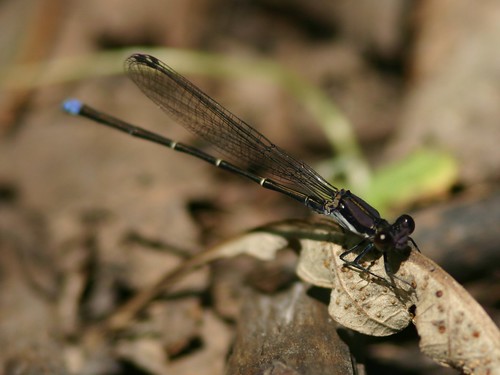
Another Pond Damselfly, probably a different species:

There was a flush of Enellagma species Damselflies. Here is a male in flight:

Enellagma species Damselflies (Male hovering over two females depositing eggs):
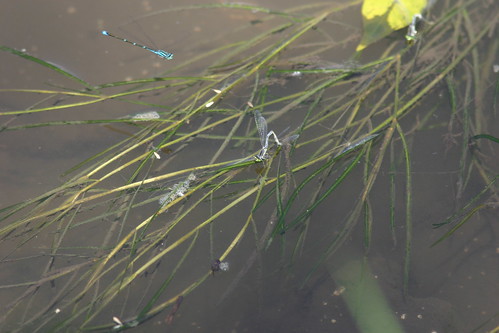
 Update on the Rosy-Finches of Sandia Crest, New Mexico. The flag stopped waving on April 2nd, when the last flocks departed. There is great summer and fall birding in the Sandia Mountains and Central New Mexico. Check out the links in rosyfinch.com for more information.
Update on the Rosy-Finches of Sandia Crest, New Mexico. The flag stopped waving on April 2nd, when the last flocks departed. There is great summer and fall birding in the Sandia Mountains and Central New Mexico. Check out the links in rosyfinch.com for more information.
Bark Beetles, Three-toes
and Fire
Happily, New Mexico had a return to colder and wetter winters the past two years. We lived there during the unusually dry period that surrounded the turn of the century. Our pinyon pines were particularly under stress, and fell victim to bark beetles. Earlier this year, New Mexico water managers expected the biggest runoff in nearly thirty years. Yet, this spring brought hot and dry winds that dessicated the forest vegetation. The Manzano Mountains, just to the south of the Sandias, suffered a major fire.
 The preceding mild and dry winters had been kind to the bark beetles. They attacked the pinyon pine trees as never before in memory, leaving huge tracts of dead and dying trees. At higher elevations, drought-stricken Ponderosa Pine and fir trees were similarly afflicted. The trunks of fallen trees blocked trails and added a huge fuel burden to the forest floor.
The preceding mild and dry winters had been kind to the bark beetles. They attacked the pinyon pine trees as never before in memory, leaving huge tracts of dead and dying trees. At higher elevations, drought-stricken Ponderosa Pine and fir trees were similarly afflicted. The trunks of fallen trees blocked trails and added a huge fuel burden to the forest floor.
Before the Manzano fire, Sandia District Ranger Cid Morgan predicted, “Don’t be surprised if we have a large, catastrophic wildfire in the East Mountains.” Citing the low moisture and the great number of dead trees lying at the floor of our overgrown forests, Morgan says “you’re talking explosive conditions, and if we get a fire in there [the Sandias] we will not be able to put it out.”
Dead and dying trees, and the beetles that feed upon them, are also favorable to woodpeckers. American Three-toed Woodpeckers specialize in stripping the bark of weakened trees to get at the plump beetle larvae. Three-toes were absent from the Sandias for over ten years, but a pair appeared near Sandia Crest in 2005. They have been seen intermittently every year and have produced at least one brood. Last week they were reported again by Celestyn Brozek, an expert Albuquerque birder.
The best place to find three-toed woodpeckers is along the Nature Trail that runs to the south from Sandia Crest, as it approaches Kiwanis Meadow. The coordinates for this location are:
Latitude 35.204286
Longitude 106.443036
bark beetles to compose a symphony– LISTEN HERE)
(Photos are from US Forest Service, Southwestern Region;
more information about Bark Beetle Infestation here)
PARTIAL CLOSURES BEGIN ON SANDIA RANGER DISTRICT
(US Forest Service Press Release)
Albuquerque, June 14, 2008 –
Beginning June 16, 2008 at 8:00 am, portions of the Sandia Ranger District on the Cibola National Forest will be closed.
“Our fuel moisture’s on the south end of the district warrant additional restrictions for the safety of the community and resource“said Cid Morgan, District Ranger. “At this time, the area North of I-40 has received more moisture and we will keep this area open under Stage 2 Restrictions for now. If dry weather continues we will implement additional restrictions North of I-40”
Beginning 8:00 am, June 16, 2008, the following areas of the Sandia Ranger District are affected:
Sandia Ranger District – South of I-40: Stage 3 Restrictions (Partial Closures)
- Pine Flat Picnic Ground and Cedro Group Campground are the only areas open south of I-40.
- All Other Areas Closed South of I-40.
- No Hiking/Motorized Vehicles allowed in Back-country and on all Trails.
- No Campfires/No Charcoal/No Stoves (Cold Picnics Only).
- Smoking in vehicles only.
North of I-40: Stage 2 Restrictions
- No Campfires/No Charcoal.
-
Pressurized liquid or gas stoves, lanterns and heaters meeting
safety specifications are allowed. - Smoking in vehicles only.
- No motorized vehicles off roads.
For more information contact the Sandia Ranger District at 505-281-3304.
For further information about closures and restrictions in the Cibola
National Forest, information is posted on the internet at
http://www.fs.
Additional fire information for the Southwest Area is available at http://publiclands.
May through October, TUESDAY MORNING GUIDED BIRD WALKS in the Sandia Mountains, sponsored by the U.S. Forest Service and Central New Mexico Birders meet at 8:00 a.m. (8:30 in May and October) at the |
| Table and Spreadsheet of all Banding Results |
Sedge Wren, AKA Short-billed Marsh Wren:
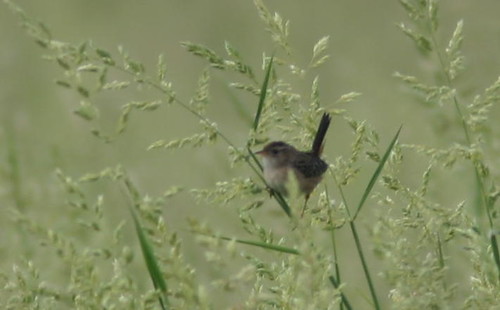
At the edge of Troy Meadows, New Jersey, in 1951, after I had been keeping bird lists for about three years, I saw my first Sedge Wren. It was the 162nd species on my life list. At that time it was called the “Short-billed Marsh Wren” to distinguish it from Its longer-billed relative, which I had identified as life bird #96 during the previous year. My first “Long-billed Marsh Wren” (now simply called Marsh Wren) was in “The Meadows” along Berry’s Creek and the Hackensack River, later to be distinguished as “The Meadowlands,” home to the NY Giants Stadium. (I described one of my childhood adventures there in an earlier post, Odd Jobs and Toxic Waste, but I digress).
So, both birds were seen in “meadows,” right? Technically, not quite. The dictionary defines a meadow as a field that contains mostly grass and non-woody plants, usually quite level, and sometimes low and moist, and often used for grazing and hay-making. This does not fit the definition of what New Jersians call a “meadow.” Both Troy Meadow and the Hackensack River meadows had standing water and dense, high cattails and phragmites reeds, and are more appropriately termed marshes. The latter “meadow” is largely a brackish tidal flat.
The Marsh Wren is aptly named, as it usually nests in the depths of such marshes or in stands of reeds and cattails along the margins of rivers and lakes. The Sedge Wren does not require “sedges,” per se, but it does nest in drier places such as fallow grazing land and open prairies, but often within sight of water.
As was my experience with the Henslow’s Sparrow, which also nests in prairie grasslands, the Sedge Wren is much easier heard than seen. It creeps under cover, mouse-like, scolding all the while. My first sighting of a Sedge Wren was of one that was perched on high grass, at quite a distance, and true to form, it was not found in the depths of Troy Meadows, but in a field that led to the boardwalk that traversed the swamp. Since then, I have captured only fleeting glimpses of the species.
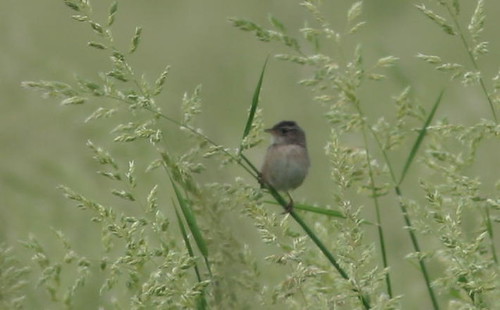
This Sedge Wren, photographed on June 10, was not very cooperative. I heard its distinctive song as we were walking along the grass track through the restored prairie at the east entrance of Dick Young/Nelson Lake Marsh Preserve, in Batavia, Illinois. It was about 40-50 yards out. Luckily, it chose to stay put for several minutes.
A Common Yellowthroat that shared the Sedge Wren’s habitat, peered out from the underbrush along the trail:
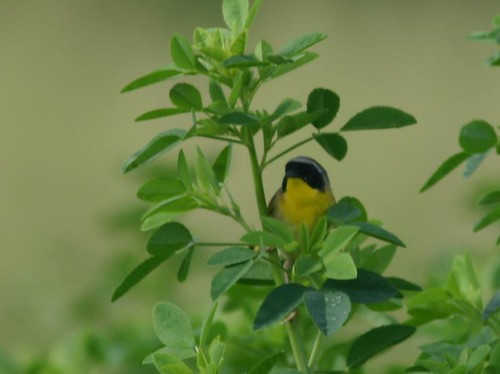
The amount of white that borders the Common Yellowthroat’s black mask iq quite variable. This bird shows quite an extensive white area:
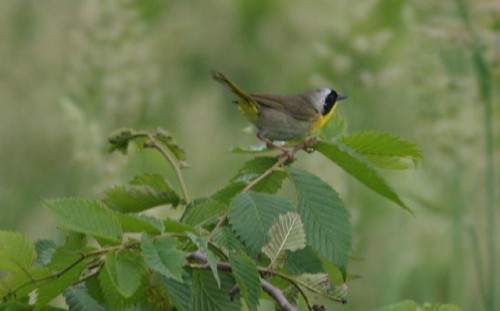
This Song Sparrow appears to be in a pensive mood:
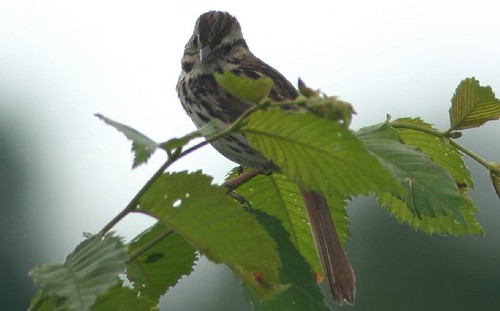
You just have to love its song:
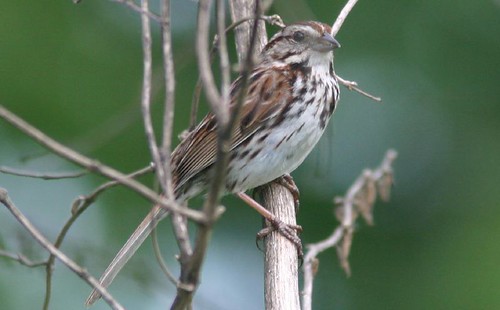
“Fitz-Byew” calls of Willow Flycatchers rang out along the margin of Nelson’s Lake. In this view, the eye ring is barely visible:
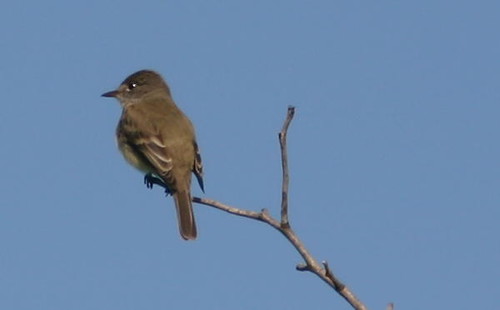
The lower mandible is lighter in color, and, in spring, the belly of the Willow Flycatcher may have a yellowish cast:
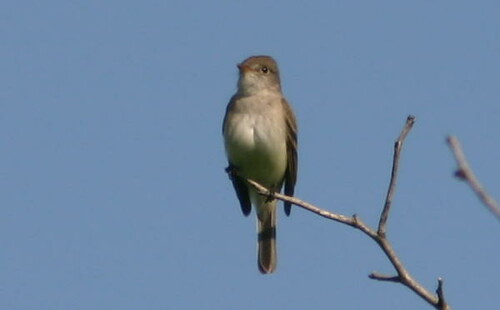
Indigo Buntings were numerous and vociferous:
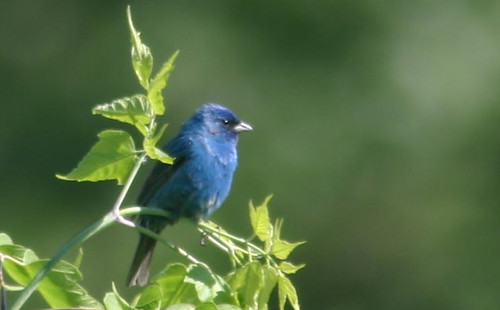
A Yellow-billed Cuckoo flew by and I snapped one shot before it disappeared. Can you find it among the branches?
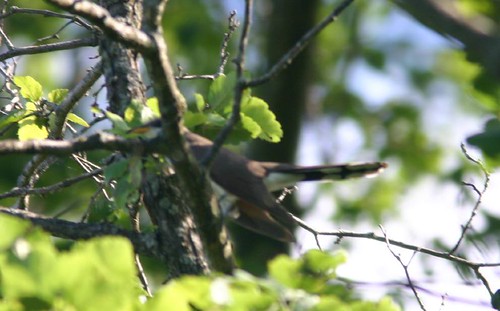
Wild white roses were in bloom: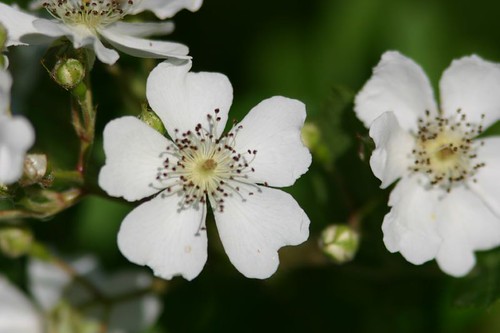
This Dicksissel was one of several we saw at Nelson Lake:
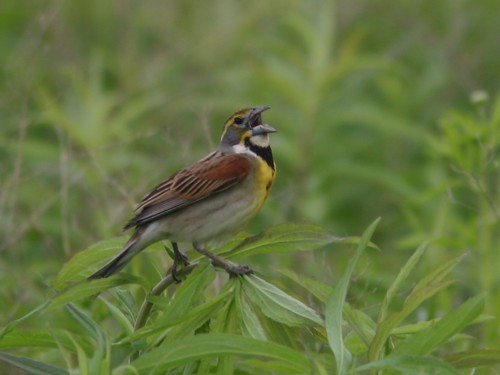
I have mentioned before how Mary Lou had scruples about “counting” a bird for her life list until she was satisfied that she had seen most or all of its field marks. (Her refusal to count her first Scarlet Tanager was a case in point.) As to this day’s target bird, Henslow’s Sparrow, we had persued it in several prairie areas, thought we heard it, and caught fleeting glimpses, through thick grass, of a frail looking, big-headed, short tailed and streaky sparrow. In good conscience, and despite the permissive American Birding Association rules of the counting game, neither of us felt comfortable “counting” it, even though we were fairly certain that we had seen one.
Naturally, as soon as we heard that one had been reported at Bill Young/Nelson Lake Marsh Forest Preserve, near our North Aurora, Illinois summer home, we hurried there. As noted in our previous blog, we did get nice views of Grasshopper Sparrows, but chilly winds and the threat of rain made us turn around before we could reach the spot where the Henslow’s Sparrow had been seen.
The next morning (June 4) dawned foggy but mild, so we tried again. The fog lifted, and cloud cover kept us comfortably cool. This time there was no wind to mask the faint trills of the Grasshopper Sparows. We entered the preserve by way of the new north entrance, which has undergone quite a bit of improvement since this map (PDF link below) was published. Now, an asphalt path, flanked by a gravel equestrian trail, loops for almost three miles around the western part of the property. It traverses mostly recovering tall grass prairie, skirting a “prairie pothole” and several other marshy areas.
Mary Lou spotted the first Dicksissel, another species that she had seen previously as a “fly-by” that went uncounted on her life list. This time the views were drop-dead pefect. I had never before seen Dicksissels in such bright plumage.
I learned that Ohio Spiderwort likes damp weather. Many of these subtly beautiful flowers punctuated the prairie landscape:
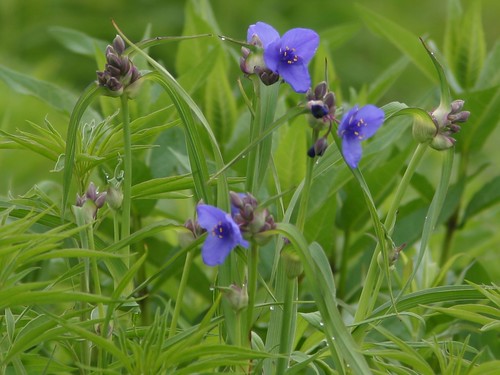
Walking leisurely and enjoying the wildflowers, we reached the south loop of the trail. Here, the character of the vegetation changed somewhat. It appeared not to have been burnt or mowed as recently as the other fields. Scattered amid the tall grass were scraggled woody shrubs, about 3 or 4 feet high. Henslow’s Sparrows are said to favor a certain stage of prairie succession after fire or disturbance, and our hopes rose.
Sure enough, we soon heard the regular, two-note chirping “ch-lip!” of a Henslow’s. It was quite loud– I expected it to be barely audible– but it was also very difficult to localize. At one point, I thought the bird was in front of me at my feet, and then realized it was behind me! Then we argued about whether it was to our right or to our left. In any event, we failed to catch sight of the bird. It stopped singing, and we continued on until the grassland became more uniform. Rather than completing the loop, we made the wise decision to retrace our steps.
Success:

This time, we heard not one, but two Henslow’s Sparrows singing, and one finally gave us views from about 30 to 40 feet– certainly adequate enough for us to discern its head and face pattern, and its pure white breast with thin brown streaking. The books say its head has a greenish cast, but we wouldn’t call that a field mark. Bill pointed to the sky, the little guy just poured out his heart with song.
Henslow’s Sparrow singing:
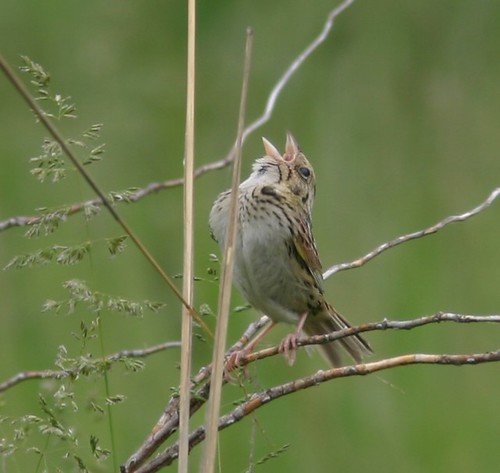
We returned home quite satisfied. We both got our life Henslow’s Sparrow, and Mary Lou was now comfortable “counting” her Dicksissel.
I am not yet very familiar with Illinois wildflowers. This showy legume is Wild Blue Indigo (Baptisia australis).
.
Click here for a PDF map of Dick Young/Nelson Lake Marsh Forest Preserve. It does not include the recent trail extensions.
http://www.kaneforest.com/fp/map/DickYoung.pdf













